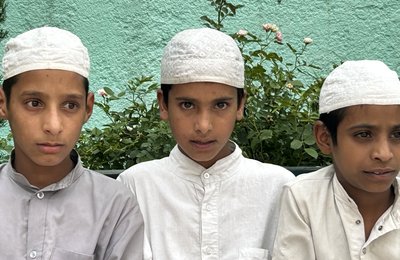Sufi-Yogi Dialogue from Insight on Conflict on Vimeo.
"If you listen to truth, curb the five; (five senses), Otherwise, you bend the body and call it namaaz (Muslim prayer). If you unite Siva (inner Being) and shunya (non-Being). That is the inner namaaz, indeed", Professor M. H. Zafar, a Muslim Shaivaite scholar captivated the gathering of Muslim Sufis, Hindu Yogis, Buddhist Monks, Humanitarians and Peace practitioners at Sufi –Yogi Dialogue from 8th -12 April 2010 organized by Global Peace Initiative of Women (GPIW) at Kathmandu as he recited the sholaks ( verse ) of Nund Rishi, Kashmir’s patron saint.
Indeed the path shown by Kashmiri mystics for co-existence for people from different faith traditions is the guidance the world needs when religious extremism, intolerance and violence is becoming a norm. The spiritual culture of Kashmir holds within it the essence of indigenous Reshi, Hindu Shaviate, Buddhist and Islamic Sufi ethos, thereby learning from the wisdom of great masters from different traditions. This makes possible the development of a contemporary framework for evolving a collective consciousness that is locally rooted but has a global identity and appeal.
Contemplating and reflecting on how to bring to fore the deeper wisdoms of all religions, a group of 30 Sufis and Vedantic practitioners from Kashmir Valley, Pakistan, India, Cambodia, Qatar USA and Nepal spent three days sharing their faith traditions, doctrines and direct experiences. As Sister Maureen of Brahma Kumaris said, ‘We have to find ways for the humanity to make a shift to finding a pathway to creating a society based on the principles of love, co-operation and peace’.
Dena Merriam is a founder GPIW. Sitting next to Taimoor Khan Mumtaz, of Shadhili Sufi Order and from Lahore, Pakistan, said in her soft voice said that one of the ways of bringing about such a shift, besides individual meditation, was to collectively go deeper into the levels of their work and help what is happening at the subtle level to manifest at the physical level.
“Walk”, said Bob Maat simply. Dressed in a plain white t-shirt, blue trousers and nylon bathroom slippers, Bob, a humanitarian and teacher, narrated how in 1992 Venerable Maha Ghosananda conceived the idea of Dhammayietra (Peace Walks) when annual month-long peace walk comprised of monks and lay people traveled through politically unstable regions of Cambodia to begin healing and promote peace.
As Bob continued to share his experiences of the many walks he has undertaken he recollected that the first Dhammayietra began in the refugee camps on the Thai border, traveled through Khmer Rouge territory and highly contested land, and ended in Phnom Phen. “We were few walkers initially, almost 100 refugee Cambodians, but hundreds of local supporters joined as we proceeded through the countryside”. He believes that the peace walk was a testament to the eagerness for peace. Both poor villagers and soldiers joined the march or received blessings from the monks. Soldiers laid down their arms and explained to the walkers that they did not want to kill anymore. Villagers gathered spontaneously in the early mornings to receive a water blessing from the monks as a means of psychological purification. And unexpectedly, walkers began to meet relatives they had not seen for decades.
With deep reverence etched on his face Bob continued to add that for Ghosananda, consciousness was the starting point for social ethics because one’s mental state generates all verbal and physical activity. All involved are personally responsible for the health of society. “When he crossed the landmined areas, he asserted that to remove landmines one has to first remove the landmines within ones heart - anger, greed and delusion.”
Swami Atmarupananda, Spiritual Teacher from the Ramakrishna Mission in USA, however said the greatest service to the world is to help “awaken the spiritual heart” and that can be attained through the path of prapati (total surrender to the grace of God) and Truth. Sharing with the participants the various ways to get to the path of prapatti and Truth Atmapurananda added, “An inclusive idea is more powerful than an exclusive one”. Sitting crossed legged in a yogic posture, wearing saffron robes he looked at the participants and mused, “My Self existence extends only upto me only so why shouldn’t I identity with the whole Universe, which is larger, more inclusive, and therefore more powerful”. This is indeed a powerful message to the world, when people want to shrink identities, exclude each other and at times even eliminate each other in the search for achieving power. “I see it as an accumulation of the negative Karma and self-destructive behavior”, said Dena thoughtfully. She asked pointedly, “How can we, a group of mystics, Sufis, yogis, practitioners rebuild or alter energy structures?”
Responding to the challenges Dr. Shezad Qaiser, author and poet from Pakistan said that spirituality cannot be sustained in a vacuum without cultural forms. “Sufi traditions have been a vital link between common man and heaven through the native language and oral traditions. When people are denied native language and oral traditions die, spirituality also dies”. Often breaking into his own native Saraiki language spoken in south eastern areas of Pakistan, Dr. Qaiser expressed poetically that the basic message of Sufis is of Unity and Diversity. “While the principle of Unity is hidden, the phenomenon of Diversity is understood by people because it is their immediate experience. When we hold dialogue, the purpose of the principle becomes unseen and unhidden”. To which Ahmed Jawaid, Deputy Director Iqbal Academy, Lahore, Pakistan eloquently added “Diversity in perceptions is not conflicting for Sufis and Yogis. However, we have to search and arrive at a workable unity, perhaps the only way to overcome the crisis in the world today.”
Ashima Kaul, Insight on Conflict, 30 April 2010








